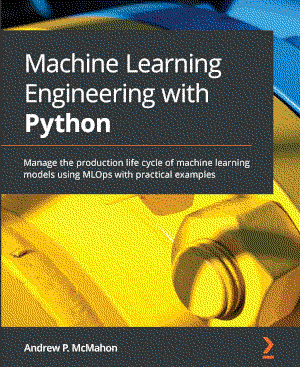Ames Housing Feature Engineering#
Missing values
Temporal variables
Non-Gaussian distributed variables
Categorical variables: remove rare labels
Categorical variables: convert strings to numbers
Put the variables in a similar scale
With the aim to ensure reproducibility between runs of the same notebook, and between the research and production environment, for each step that includes some element of randomness, it is extremely important that the seed is set.
Libraries and packages#
1# to handle datasets
2import pandas as pd
3import numpy as np
4
5# for plotting
6import matplotlib.pyplot as plt
7
8# for the yeo-johnson transformation
9import scipy.stats as stats
10
11# to divide train and test set
12from sklearn.model_selection import train_test_split
13
14# feature scaling
15from sklearn.preprocessing import MinMaxScaler
16
17# to save the trained scaler class
18import joblib
19
20# to visualise al the columns in the dataframe
21pd.pandas.set_option("display.max_columns", None)
Paths#
1# Path to datasets directory
2data_path = "./datasets"
3# Path to assets directory (for saving results to)
4assets_path = "./assets"
Loading dataset#
1data = pd.read_csv(f"{data_path}/train.csv")
2
3print(data.shape)
4data.head()
(1460, 81)
| Id | MSSubClass | MSZoning | LotFrontage | LotArea | Street | Alley | LotShape | LandContour | Utilities | LotConfig | LandSlope | Neighborhood | Condition1 | Condition2 | BldgType | HouseStyle | OverallQual | OverallCond | YearBuilt | YearRemodAdd | RoofStyle | RoofMatl | Exterior1st | Exterior2nd | MasVnrType | MasVnrArea | ExterQual | ExterCond | Foundation | BsmtQual | BsmtCond | BsmtExposure | BsmtFinType1 | BsmtFinSF1 | BsmtFinType2 | BsmtFinSF2 | BsmtUnfSF | TotalBsmtSF | Heating | HeatingQC | CentralAir | Electrical | 1stFlrSF | 2ndFlrSF | LowQualFinSF | GrLivArea | BsmtFullBath | BsmtHalfBath | FullBath | HalfBath | BedroomAbvGr | KitchenAbvGr | KitchenQual | TotRmsAbvGrd | Functional | Fireplaces | FireplaceQu | GarageType | GarageYrBlt | GarageFinish | GarageCars | GarageArea | GarageQual | GarageCond | PavedDrive | WoodDeckSF | OpenPorchSF | EnclosedPorch | 3SsnPorch | ScreenPorch | PoolArea | PoolQC | Fence | MiscFeature | MiscVal | MoSold | YrSold | SaleType | SaleCondition | SalePrice | |
|---|---|---|---|---|---|---|---|---|---|---|---|---|---|---|---|---|---|---|---|---|---|---|---|---|---|---|---|---|---|---|---|---|---|---|---|---|---|---|---|---|---|---|---|---|---|---|---|---|---|---|---|---|---|---|---|---|---|---|---|---|---|---|---|---|---|---|---|---|---|---|---|---|---|---|---|---|---|---|---|---|---|
| 0 | 1 | 60 | RL | 65.0 | 8450 | Pave | NaN | Reg | Lvl | AllPub | Inside | Gtl | CollgCr | Norm | Norm | 1Fam | 2Story | 7 | 5 | 2003 | 2003 | Gable | CompShg | VinylSd | VinylSd | BrkFace | 196.0 | Gd | TA | PConc | Gd | TA | No | GLQ | 706 | Unf | 0 | 150 | 856 | GasA | Ex | Y | SBrkr | 856 | 854 | 0 | 1710 | 1 | 0 | 2 | 1 | 3 | 1 | Gd | 8 | Typ | 0 | NaN | Attchd | 2003.0 | RFn | 2 | 548 | TA | TA | Y | 0 | 61 | 0 | 0 | 0 | 0 | NaN | NaN | NaN | 0 | 2 | 2008 | WD | Normal | 208500 |
| 1 | 2 | 20 | RL | 80.0 | 9600 | Pave | NaN | Reg | Lvl | AllPub | FR2 | Gtl | Veenker | Feedr | Norm | 1Fam | 1Story | 6 | 8 | 1976 | 1976 | Gable | CompShg | MetalSd | MetalSd | None | 0.0 | TA | TA | CBlock | Gd | TA | Gd | ALQ | 978 | Unf | 0 | 284 | 1262 | GasA | Ex | Y | SBrkr | 1262 | 0 | 0 | 1262 | 0 | 1 | 2 | 0 | 3 | 1 | TA | 6 | Typ | 1 | TA | Attchd | 1976.0 | RFn | 2 | 460 | TA | TA | Y | 298 | 0 | 0 | 0 | 0 | 0 | NaN | NaN | NaN | 0 | 5 | 2007 | WD | Normal | 181500 |
| 2 | 3 | 60 | RL | 68.0 | 11250 | Pave | NaN | IR1 | Lvl | AllPub | Inside | Gtl | CollgCr | Norm | Norm | 1Fam | 2Story | 7 | 5 | 2001 | 2002 | Gable | CompShg | VinylSd | VinylSd | BrkFace | 162.0 | Gd | TA | PConc | Gd | TA | Mn | GLQ | 486 | Unf | 0 | 434 | 920 | GasA | Ex | Y | SBrkr | 920 | 866 | 0 | 1786 | 1 | 0 | 2 | 1 | 3 | 1 | Gd | 6 | Typ | 1 | TA | Attchd | 2001.0 | RFn | 2 | 608 | TA | TA | Y | 0 | 42 | 0 | 0 | 0 | 0 | NaN | NaN | NaN | 0 | 9 | 2008 | WD | Normal | 223500 |
| 3 | 4 | 70 | RL | 60.0 | 9550 | Pave | NaN | IR1 | Lvl | AllPub | Corner | Gtl | Crawfor | Norm | Norm | 1Fam | 2Story | 7 | 5 | 1915 | 1970 | Gable | CompShg | Wd Sdng | Wd Shng | None | 0.0 | TA | TA | BrkTil | TA | Gd | No | ALQ | 216 | Unf | 0 | 540 | 756 | GasA | Gd | Y | SBrkr | 961 | 756 | 0 | 1717 | 1 | 0 | 1 | 0 | 3 | 1 | Gd | 7 | Typ | 1 | Gd | Detchd | 1998.0 | Unf | 3 | 642 | TA | TA | Y | 0 | 35 | 272 | 0 | 0 | 0 | NaN | NaN | NaN | 0 | 2 | 2006 | WD | Abnorml | 140000 |
| 4 | 5 | 60 | RL | 84.0 | 14260 | Pave | NaN | IR1 | Lvl | AllPub | FR2 | Gtl | NoRidge | Norm | Norm | 1Fam | 2Story | 8 | 5 | 2000 | 2000 | Gable | CompShg | VinylSd | VinylSd | BrkFace | 350.0 | Gd | TA | PConc | Gd | TA | Av | GLQ | 655 | Unf | 0 | 490 | 1145 | GasA | Ex | Y | SBrkr | 1145 | 1053 | 0 | 2198 | 1 | 0 | 2 | 1 | 4 | 1 | Gd | 9 | Typ | 1 | TA | Attchd | 2000.0 | RFn | 3 | 836 | TA | TA | Y | 192 | 84 | 0 | 0 | 0 | 0 | NaN | NaN | NaN | 0 | 12 | 2008 | WD | Normal | 250000 |
Separate dataset into train and test#
When engineering features, some techniques learn parameters from data. It is important to learn these parameters only from the train set to avoid over-fitting.
Feature engineering techniques:
mean
mode
exponents for the yeo-johnson
category frequency
and category to number mappings
Separating the data into train and test involves randomness. Set the seed.
1# Separate into train and test set and set the seed
2# (random_state for this sklearn function)
3
4X_train, X_test, y_train, y_test = train_test_split(
5 data.drop(["Id", "SalePrice"], axis=1), # predictive variables
6 data["SalePrice"], # target
7 test_size=0.1, # portion of dataset to allocate to test set
8 random_state=0, # we are setting the seed here
9)
10
11X_train.shape, X_test.shape
((1314, 79), (146, 79))
Target#
Apply the logarithm (see EDA)
1y_train = np.log(y_train)
2y_test = np.log(y_test)
Missing values#
Categorical variables#
Replacing missing values with the string “missing” in variables with a lot of missing data.
Alternatively, replacing missing data with the most frequent category in those variables that contain fewer observations without values.
1# Identifying the categorical variables (type object)
2
3cat_vars = [var for var in data.columns if data[var].dtype == "O"]
4
5# MSSubClass is also categorical by definition, despite its numeric values
6# (you can find the definitions of the variables in the data_description.txt
7# file available on Kaggle, in the same website where you downloaded the data)
8
9# Add MSSubClass to the list of categorical variables
10cat_vars = cat_vars + ["MSSubClass"]
11
12# cast categorical
13X_train[cat_vars] = X_train[cat_vars].astype("O")
14X_test[cat_vars] = X_test[cat_vars].astype("O")
15
16# number of categorical variables
17len(cat_vars)
44
1# List of the categorical variables that contain missing values
2cat_vars_with_na = [var for var in cat_vars if X_train[var].isnull().sum() > 0]
3
4# print percentage of missing values per variable
5X_train[cat_vars_with_na].isnull().mean().sort_values(ascending=False)
PoolQC 0.995434
MiscFeature 0.961187
Alley 0.938356
Fence 0.814307
FireplaceQu 0.472603
GarageType 0.056317
GarageFinish 0.056317
GarageQual 0.056317
GarageCond 0.056317
BsmtExposure 0.025114
BsmtFinType2 0.025114
BsmtQual 0.024353
BsmtCond 0.024353
BsmtFinType1 0.024353
MasVnrType 0.004566
Electrical 0.000761
dtype: float64
1# variables to impute with the string missing
2with_string_missing = [
3 var for var in cat_vars_with_na if X_train[var].isnull().mean() > 0.1
4]
5
6# variables to impute with the most frequent category
7with_frequent_category = [
8 var for var in cat_vars_with_na if X_train[var].isnull().mean() < 0.1
9]
1with_string_missing
['Alley', 'FireplaceQu', 'PoolQC', 'Fence', 'MiscFeature']
1# Replacing missing values with new label: "Missing"
2X_train[with_string_missing] = X_train[with_string_missing].fillna("Missing")
3X_test[with_string_missing] = X_test[with_string_missing].fillna("Missing")
1for var in with_frequent_category:
2
3 # there can be more than 1 mode in a variable
4 # we take the first one with [0]
5 mode = X_train[var].mode()[0]
6
7 print(var, mode)
8
9 X_train[var].fillna(mode, inplace=True)
10 X_test[var].fillna(mode, inplace=True)
MasVnrType None
BsmtQual TA
BsmtCond TA
BsmtExposure No
BsmtFinType1 Unf
BsmtFinType2 Unf
Electrical SBrkr
GarageType Attchd
GarageFinish Unf
GarageQual TA
GarageCond TA
1# check that no missing information in the engineered variables
2X_train[cat_vars_with_na].isnull().sum()
Alley 0
MasVnrType 0
BsmtQual 0
BsmtCond 0
BsmtExposure 0
BsmtFinType1 0
BsmtFinType2 0
Electrical 0
FireplaceQu 0
GarageType 0
GarageFinish 0
GarageQual 0
GarageCond 0
PoolQC 0
Fence 0
MiscFeature 0
dtype: int64
1# check test set does not contain null values in the engineered variables
2[var for var in cat_vars_with_na if X_test[var].isnull().sum() > 0]
[]
Numerical variables#
To engineer missing values in numerical variables:
add a binary missing indicator variable
and then replace the missing values in the original variable with the mean
1# Identifying the numerical variables
2num_vars = [
3 var
4 for var in X_train.columns
5 if var not in cat_vars and var != "SalePrice"
6]
7
8# number of numerical variables
9len(num_vars)
35
1# List with the numerical variables that contain missing values
2vars_with_na = [var for var in num_vars if X_train[var].isnull().sum() > 0]
3
4# print percentage of missing values per variable
5X_train[vars_with_na].isnull().mean()
LotFrontage 0.177321
MasVnrArea 0.004566
GarageYrBlt 0.056317
dtype: float64
1# Replacing missing values as described above
2for var in vars_with_na:
3
4 # calculate the mean using the train set
5 mean_val = X_train[var].mean()
6
7 print(var, mean_val)
8
9 # add binary missing indicator (in train and test)
10 X_train[var + "_na"] = np.where(X_train[var].isnull(), 1, 0)
11 X_test[var + "_na"] = np.where(X_test[var].isnull(), 1, 0)
12
13 # replace missing values by the mean
14 # (in train and test)
15 X_train[var].fillna(mean_val, inplace=True)
16 X_test[var].fillna(mean_val, inplace=True)
17
18# check no more missing values in the engineered variables
19X_train[vars_with_na].isnull().sum()
LotFrontage 69.87974098057354
MasVnrArea 103.7974006116208
GarageYrBlt 1978.2959677419356
LotFrontage 0
MasVnrArea 0
GarageYrBlt 0
dtype: int64
1# check test set does not contain null values in the engineered variables
2[var for var in vars_with_na if X_test[var].isnull().sum() > 0]
[]
1# check the binary missing indicator variables
2X_train[["LotFrontage_na", "MasVnrArea_na", "GarageYrBlt_na"]].head()
| LotFrontage_na | MasVnrArea_na | GarageYrBlt_na | |
|---|---|---|---|
| 930 | 0 | 0 | 0 |
| 656 | 0 | 0 | 0 |
| 45 | 0 | 0 | 0 |
| 1348 | 1 | 0 | 0 |
| 55 | 0 | 0 | 0 |
Temporal variables#
Capture elapsed time#
From EDA, there are 4 variables that refer to the years in which the house or the garage were built or remodeled. Capturing the time elapsed between those variables and the year in which the house was sold:
1def elapsed_years(df, var):
2 # capture difference between the year variable
3 # and the year in which the house was sold
4 df[var] = df["YrSold"] - df[var]
5 return df
1for var in ["YearBuilt", "YearRemodAdd", "GarageYrBlt"]:
2 X_train = elapsed_years(X_train, var)
3 X_test = elapsed_years(X_test, var)
1# now drop YrSold
2X_train.drop(["YrSold"], axis=1, inplace=True)
3X_test.drop(["YrSold"], axis=1, inplace=True)
Numerical variable transformation#
Logarithmic transformation#
From EDA, the numerical variables are not normally distributed. Transforming the positive numerical variables with the logarithm in order to get more Gaussian-like distributions.
1for var in ["LotFrontage", "1stFlrSF", "GrLivArea"]:
2 X_train[var] = np.log(X_train[var])
3 X_test[var] = np.log(X_test[var])
1# check test set does not contain null values in the engineered variables
2[
3 var
4 for var in ["LotFrontage", "1stFlrSF", "GrLivArea"]
5 if X_test[var].isnull().sum() > 0
6]
[]
1# same for train set
2[
3 var
4 for var in ["LotFrontage", "1stFlrSF", "GrLivArea"]
5 if X_train[var].isnull().sum() > 0
6]
[]
Yeo-Johnson transformation#
Applying the Yeo-Johnson transformation to LotArea.
1# the yeo-johnson transformation learns the best exponent to transform
2# the variable it needs to learn it from the train set:
3X_train["LotArea"], param = stats.yeojohnson(X_train["LotArea"])
4
5# and then apply the transformation to the test set with the same
6# parameter: see who this time we pass param as argument to the
7# yeo-johnson
8X_test["LotArea"] = stats.yeojohnson(X_test["LotArea"], lmbda=param)
9
10print(param)
0.017755573660304995
1# check absence of na in the train set
2[var for var in X_train.columns if X_train[var].isnull().sum() > 0]
[]
1# check absence of na in the test set
2[var for var in X_train.columns if X_test[var].isnull().sum() > 0]
[]
Binarize skewed variables#
A few variables were very skewed, transforming into binary variables.
1skewed = [
2 "BsmtFinSF2",
3 "LowQualFinSF",
4 "EnclosedPorch",
5 "3SsnPorch",
6 "ScreenPorch",
7 "MiscVal",
8]
9
10for var in skewed:
11
12 # map the variable values into 0 and 1
13 X_train[var] = np.where(X_train[var] == 0, 0, 1)
14 X_test[var] = np.where(X_test[var] == 0, 0, 1)
Categorical variables#
Apply mappings#
1# Re-mapping string to number (determine quality)
2qual_mappings = {
3 "Po": 1,
4 "Fa": 2,
5 "TA": 3,
6 "Gd": 4,
7 "Ex": 5,
8 "Missing": 0,
9 "NA": 0,
10}
11
12qual_vars = [
13 "ExterQual",
14 "ExterCond",
15 "BsmtQual",
16 "BsmtCond",
17 "HeatingQC",
18 "KitchenQual",
19 "FireplaceQu",
20 "GarageQual",
21 "GarageCond",
22]
23
24for var in qual_vars:
25 X_train[var] = X_train[var].map(qual_mappings)
26 X_test[var] = X_test[var].map(qual_mappings)
1exposure_mappings = {"No": 1, "Mn": 2, "Av": 3, "Gd": 4}
2
3var = "BsmtExposure"
4
5X_train[var] = X_train[var].map(exposure_mappings)
6X_test[var] = X_test[var].map(exposure_mappings)
1finish_mappings = {
2 "Missing": 0,
3 "NA": 0,
4 "Unf": 1,
5 "LwQ": 2,
6 "Rec": 3,
7 "BLQ": 4,
8 "ALQ": 5,
9 "GLQ": 6,
10}
11
12finish_vars = ["BsmtFinType1", "BsmtFinType2"]
13
14for var in finish_vars:
15 X_train[var] = X_train[var].map(finish_mappings)
16 X_test[var] = X_test[var].map(finish_mappings)
1garage_mappings = {"Missing": 0, "NA": 0, "Unf": 1, "RFn": 2, "Fin": 3}
2
3var = "GarageFinish"
4
5X_train[var] = X_train[var].map(garage_mappings)
6X_test[var] = X_test[var].map(garage_mappings)
1fence_mappings = {
2 "Missing": 0,
3 "NA": 0,
4 "MnWw": 1,
5 "GdWo": 2,
6 "MnPrv": 3,
7 "GdPrv": 4,
8}
9
10var = "Fence"
11
12X_train[var] = X_train[var].map(fence_mappings)
13X_test[var] = X_test[var].map(fence_mappings)
1# check absence of na in the train set
2[var for var in X_train.columns if X_train[var].isnull().sum() > 0]
[]
Removing Rare Labels#
Grouping the remaining categorical variables present in less than 1% of the observations. That is, all values of categorical variables that are shared by less than 1% of houses, will be replaced by the string “Rare”.
1# Capturing all quality variables
2qual_vars = qual_vars + finish_vars + ["BsmtExposure", "GarageFinish", "Fence"]
3
4# Capturing the remaining categorical variables
5# (those that were not re-mapped)
6
7cat_others = [var for var in cat_vars if var not in qual_vars]
8
9len(cat_others)
30
1def find_frequent_labels(df, var, rare_perc):
2
3 # function finds the labels that are shared by more than
4 # a certain % of the houses in the dataset
5
6 df = df.copy()
7
8 tmp = df.groupby(var)[var].count() / len(df)
9
10 return tmp[tmp > rare_perc].index
11
12
13for var in cat_others:
14
15 # find the frequent categories
16 frequent_ls = find_frequent_labels(X_train, var, 0.01)
17
18 print(var, frequent_ls)
19 print()
20
21 # replace rare categories by the string "Rare"
22 X_train[var] = np.where(
23 X_train[var].isin(frequent_ls), X_train[var], "Rare"
24 )
25
26 X_test[var] = np.where(X_test[var].isin(frequent_ls), X_test[var], "Rare")
MSZoning Index(['FV', 'RH', 'RL', 'RM'], dtype='object', name='MSZoning')
Street Index(['Pave'], dtype='object', name='Street')
Alley Index(['Grvl', 'Missing', 'Pave'], dtype='object', name='Alley')
LotShape Index(['IR1', 'IR2', 'Reg'], dtype='object', name='LotShape')
LandContour Index(['Bnk', 'HLS', 'Low', 'Lvl'], dtype='object', name='LandContour')
Utilities Index(['AllPub'], dtype='object', name='Utilities')
LotConfig Index(['Corner', 'CulDSac', 'FR2', 'Inside'], dtype='object', name='LotConfig')
LandSlope Index(['Gtl', 'Mod'], dtype='object', name='LandSlope')
Neighborhood Index(['Blmngtn', 'BrDale', 'BrkSide', 'ClearCr', 'CollgCr', 'Crawfor',
'Edwards', 'Gilbert', 'IDOTRR', 'MeadowV', 'Mitchel', 'NAmes', 'NWAmes',
'NoRidge', 'NridgHt', 'OldTown', 'SWISU', 'Sawyer', 'SawyerW',
'Somerst', 'StoneBr', 'Timber'],
dtype='object', name='Neighborhood')
Condition1 Index(['Artery', 'Feedr', 'Norm', 'PosN', 'RRAn'], dtype='object', name='Condition1')
Condition2 Index(['Norm'], dtype='object', name='Condition2')
BldgType Index(['1Fam', '2fmCon', 'Duplex', 'Twnhs', 'TwnhsE'], dtype='object', name='BldgType')
HouseStyle Index(['1.5Fin', '1Story', '2Story', 'SFoyer', 'SLvl'], dtype='object', name='HouseStyle')
RoofStyle Index(['Gable', 'Hip'], dtype='object', name='RoofStyle')
RoofMatl Index(['CompShg'], dtype='object', name='RoofMatl')
Exterior1st Index(['AsbShng', 'BrkFace', 'CemntBd', 'HdBoard', 'MetalSd', 'Plywood',
'Stucco', 'VinylSd', 'Wd Sdng', 'WdShing'],
dtype='object', name='Exterior1st')
Exterior2nd Index(['AsbShng', 'BrkFace', 'CmentBd', 'HdBoard', 'MetalSd', 'Plywood',
'Stucco', 'VinylSd', 'Wd Sdng', 'Wd Shng'],
dtype='object', name='Exterior2nd')
MasVnrType Index(['BrkFace', 'None', 'Stone'], dtype='object', name='MasVnrType')
Foundation Index(['BrkTil', 'CBlock', 'PConc', 'Slab'], dtype='object', name='Foundation')
Heating Index(['GasA', 'GasW'], dtype='object', name='Heating')
CentralAir Index(['N', 'Y'], dtype='object', name='CentralAir')
Electrical Index(['FuseA', 'FuseF', 'SBrkr'], dtype='object', name='Electrical')
Functional Index(['Min1', 'Min2', 'Mod', 'Typ'], dtype='object', name='Functional')
GarageType Index(['Attchd', 'Basment', 'BuiltIn', 'Detchd'], dtype='object', name='GarageType')
PavedDrive Index(['N', 'P', 'Y'], dtype='object', name='PavedDrive')
PoolQC Index(['Missing'], dtype='object', name='PoolQC')
MiscFeature Index(['Missing', 'Shed'], dtype='object', name='MiscFeature')
SaleType Index(['COD', 'New', 'WD'], dtype='object', name='SaleType')
SaleCondition Index(['Abnorml', 'Family', 'Normal', 'Partial'], dtype='object', name='SaleCondition')
MSSubClass Int64Index([20, 30, 50, 60, 70, 75, 80, 85, 90, 120, 160, 190], dtype='int64', name='MSSubClass')
Encoding of categorical variables#
Next, we need to transform the strings of the categorical variables into numbers.
We will do it so that we capture the monotonic relationship between the label and the target.
To learn more about how to encode categorical variables visit our course Feature Engineering for Machine Learning in Udemy.
1# this function will assign discrete values to the strings of the variables,
2# so that the smaller value corresponds to the category that shows the smaller
3# mean house sale price
4
5
6def replace_categories(train, test, ytrain, var, target):
7
8 tmp = pd.concat([X_train, ytrain], axis=1)
9
10 # order the categories in a variable from that with the lowest
11 # house sale price, to that with the highest
12 ordered_labels = tmp.groupby([var])[target].mean().sort_values().index
13
14 # create a dictionary of ordered categories to integer values
15 ordinal_label = {k: i for i, k in enumerate(ordered_labels, 0)}
16
17 print(var, ordinal_label)
18 print()
19
20 # use the dictionary to replace the categorical strings by integers
21 train[var] = train[var].map(ordinal_label)
22 test[var] = test[var].map(ordinal_label)
1for var in cat_others:
2 replace_categories(X_train, X_test, y_train, var, "SalePrice")
MSZoning {'Rare': 0, 'RM': 1, 'RH': 2, 'RL': 3, 'FV': 4}
Street {'Rare': 0, 'Pave': 1}
Alley {'Grvl': 0, 'Pave': 1, 'Missing': 2}
LotShape {'Reg': 0, 'IR1': 1, 'Rare': 2, 'IR2': 3}
LandContour {'Bnk': 0, 'Lvl': 1, 'Low': 2, 'HLS': 3}
Utilities {'Rare': 0, 'AllPub': 1}
LotConfig {'Inside': 0, 'FR2': 1, 'Corner': 2, 'Rare': 3, 'CulDSac': 4}
LandSlope {'Gtl': 0, 'Mod': 1, 'Rare': 2}
Neighborhood {'IDOTRR': 0, 'MeadowV': 1, 'BrDale': 2, 'Edwards': 3, 'BrkSide': 4, 'OldTown': 5, 'Sawyer': 6, 'SWISU': 7, 'NAmes': 8, 'Mitchel': 9, 'SawyerW': 10, 'Rare': 11, 'NWAmes': 12, 'Gilbert': 13, 'Blmngtn': 14, 'CollgCr': 15, 'Crawfor': 16, 'ClearCr': 17, 'Somerst': 18, 'Timber': 19, 'StoneBr': 20, 'NridgHt': 21, 'NoRidge': 22}
Condition1 {'Artery': 0, 'Feedr': 1, 'Norm': 2, 'RRAn': 3, 'Rare': 4, 'PosN': 5}
Condition2 {'Rare': 0, 'Norm': 1}
BldgType {'2fmCon': 0, 'Duplex': 1, 'Twnhs': 2, '1Fam': 3, 'TwnhsE': 4}
HouseStyle {'SFoyer': 0, '1.5Fin': 1, 'Rare': 2, '1Story': 3, 'SLvl': 4, '2Story': 5}
RoofStyle {'Gable': 0, 'Rare': 1, 'Hip': 2}
RoofMatl {'CompShg': 0, 'Rare': 1}
Exterior1st {'AsbShng': 0, 'Wd Sdng': 1, 'WdShing': 2, 'MetalSd': 3, 'Stucco': 4, 'Rare': 5, 'HdBoard': 6, 'Plywood': 7, 'BrkFace': 8, 'CemntBd': 9, 'VinylSd': 10}
Exterior2nd {'AsbShng': 0, 'Wd Sdng': 1, 'MetalSd': 2, 'Wd Shng': 3, 'Stucco': 4, 'Rare': 5, 'HdBoard': 6, 'Plywood': 7, 'BrkFace': 8, 'CmentBd': 9, 'VinylSd': 10}
MasVnrType {'Rare': 0, 'None': 1, 'BrkFace': 2, 'Stone': 3}
Foundation {'Slab': 0, 'BrkTil': 1, 'CBlock': 2, 'Rare': 3, 'PConc': 4}
Heating {'Rare': 0, 'GasW': 1, 'GasA': 2}
CentralAir {'N': 0, 'Y': 1}
Electrical {'Rare': 0, 'FuseF': 1, 'FuseA': 2, 'SBrkr': 3}
Functional {'Rare': 0, 'Min2': 1, 'Mod': 2, 'Min1': 3, 'Typ': 4}
GarageType {'Rare': 0, 'Detchd': 1, 'Basment': 2, 'Attchd': 3, 'BuiltIn': 4}
PavedDrive {'N': 0, 'P': 1, 'Y': 2}
PoolQC {'Missing': 0, 'Rare': 1}
MiscFeature {'Rare': 0, 'Shed': 1, 'Missing': 2}
SaleType {'COD': 0, 'Rare': 1, 'WD': 2, 'New': 3}
SaleCondition {'Rare': 0, 'Abnorml': 1, 'Family': 2, 'Normal': 3, 'Partial': 4}
MSSubClass {30: 0, 'Rare': 1, 190: 2, 90: 3, 160: 4, 50: 5, 85: 6, 70: 7, 80: 8, 20: 9, 75: 10, 120: 11, 60: 12}
1# check absence of na in the train set
2[var for var in X_train.columns if X_train[var].isnull().sum() > 0]
[]
1# check absence of na in the test set
2[var for var in X_test.columns if X_test[var].isnull().sum() > 0]
[]
1# let me show you what I mean by monotonic relationship
2# between labels and target
3
4
5def analyse_vars(train, ytrain, var):
6
7 # function plots median house sale price per encoded
8 # category
9
10 tmp = pd.concat([X_train, np.log(ytrain)], axis=1)
11
12 tmp.groupby(var)["SalePrice"].median().plot.bar()
13 plt.title(var)
14 plt.ylim(2.2, 2.6)
15 plt.ylabel("SalePrice")
16 plt.show()
17
18
19for var in cat_others:
20 analyse_vars(X_train, y_train, var)

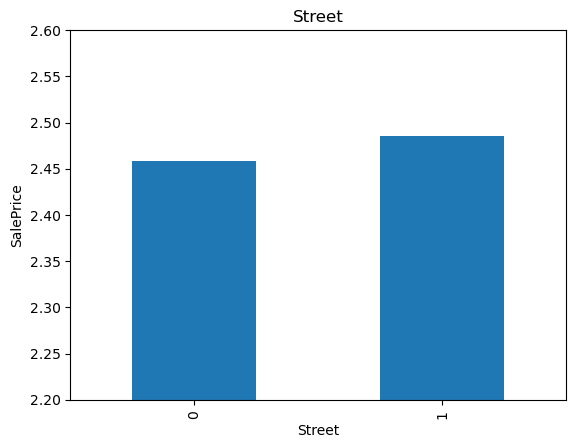
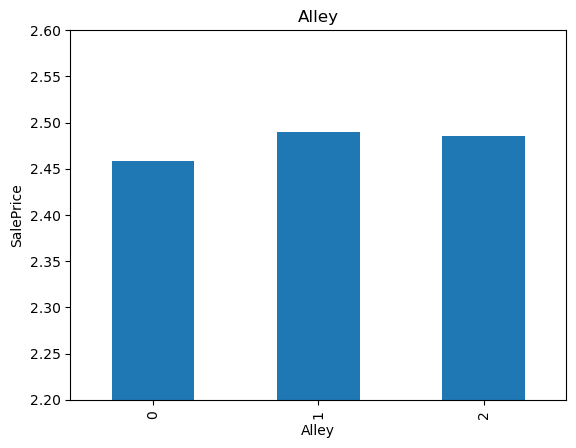


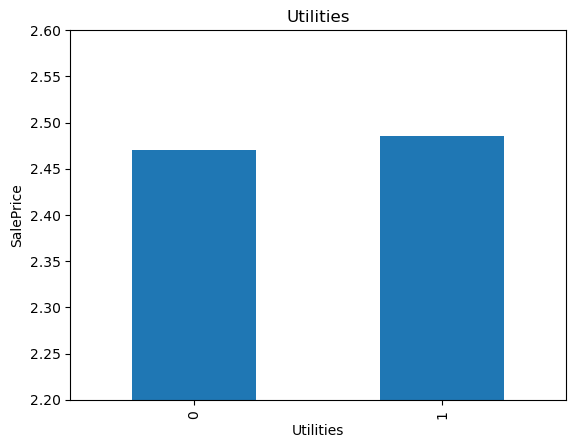

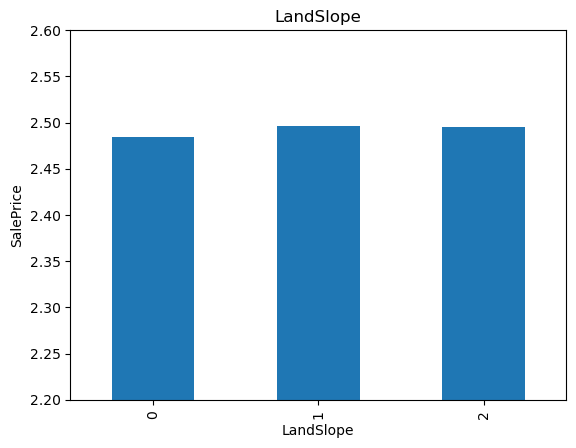

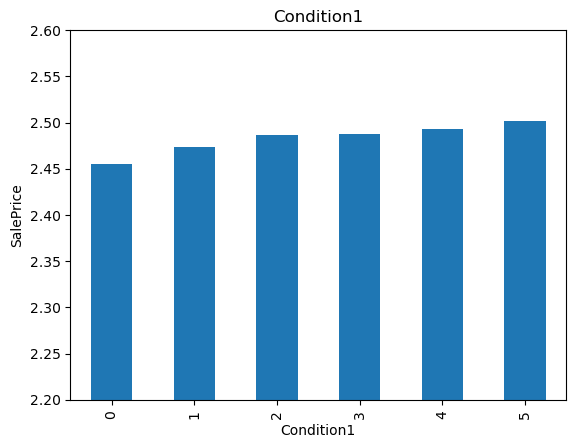
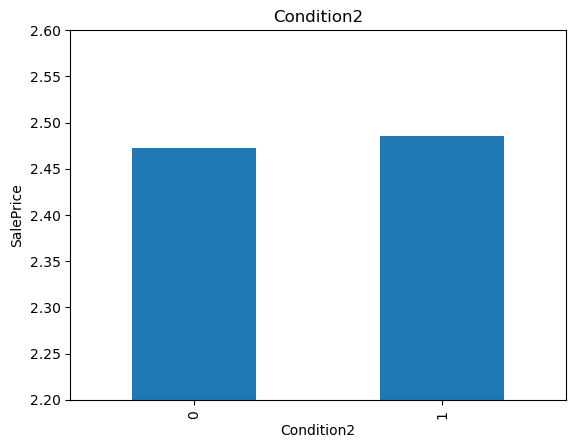
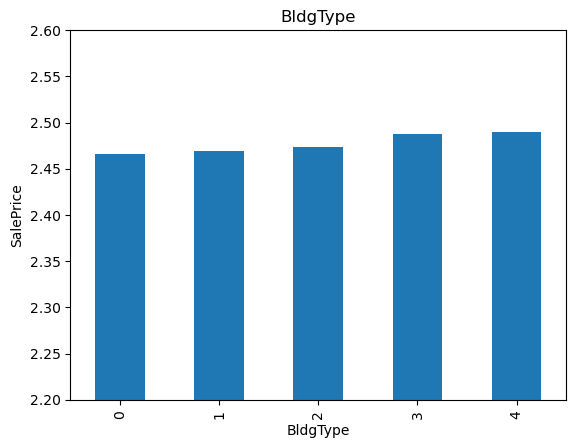



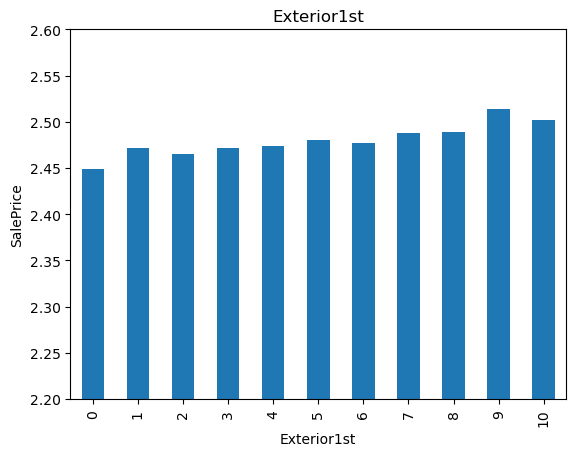
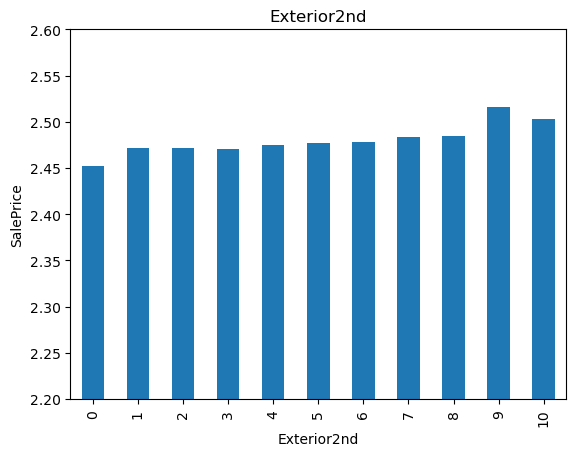
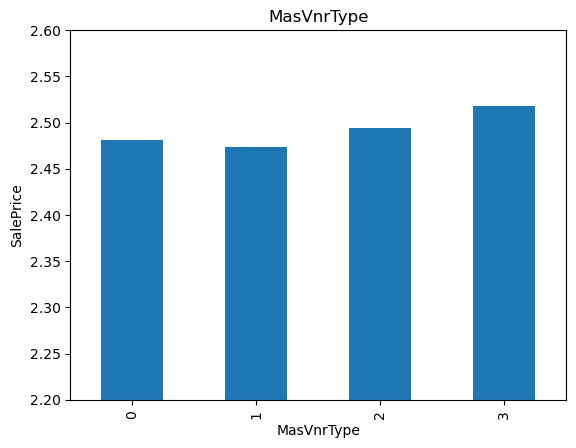
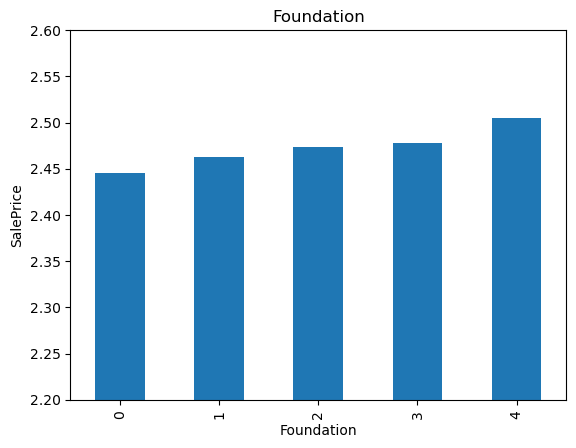

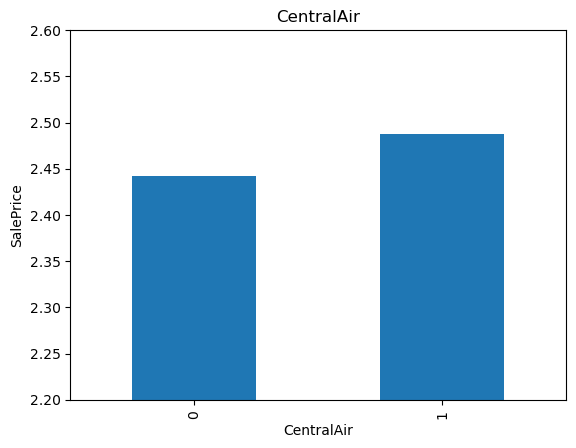
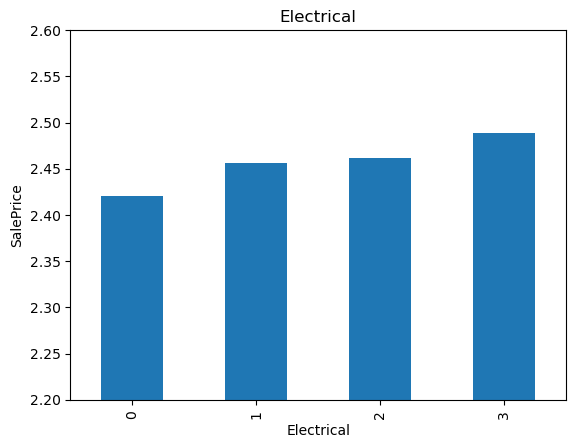
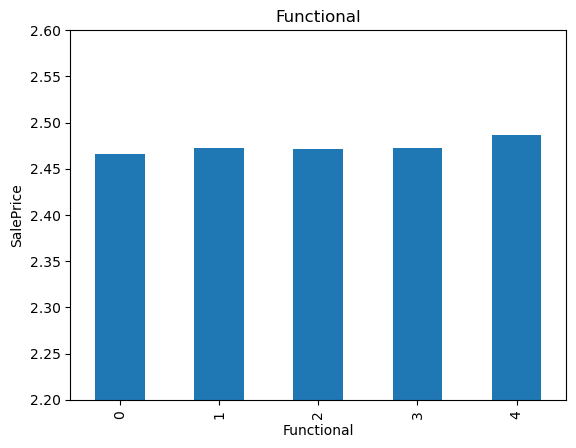
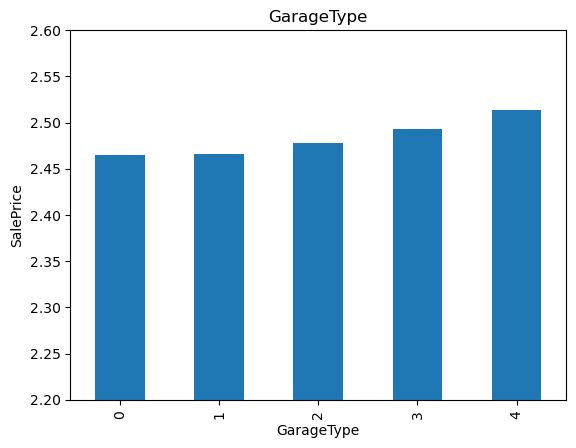
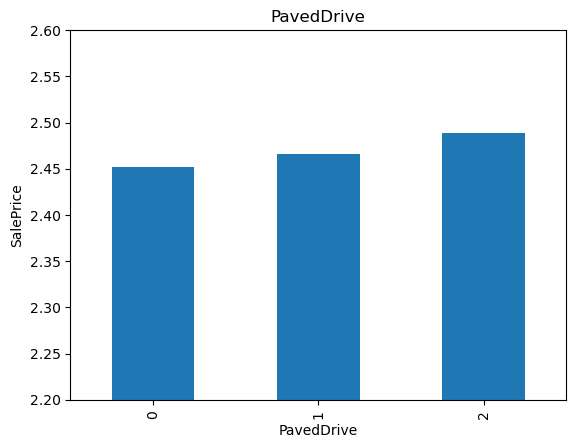
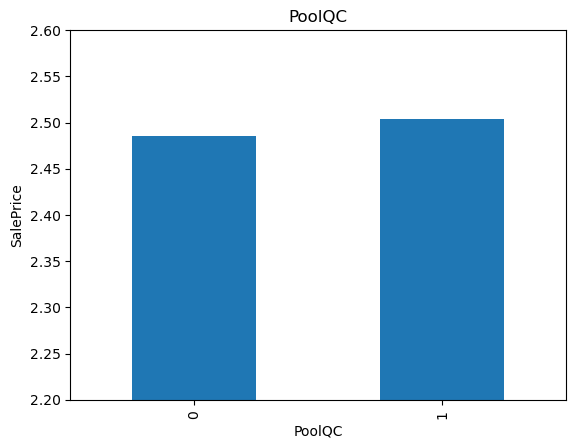
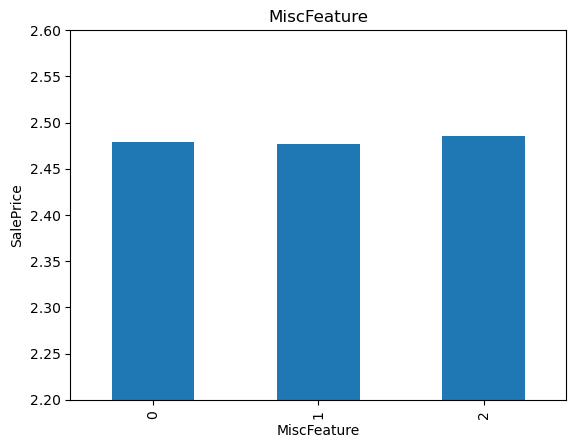
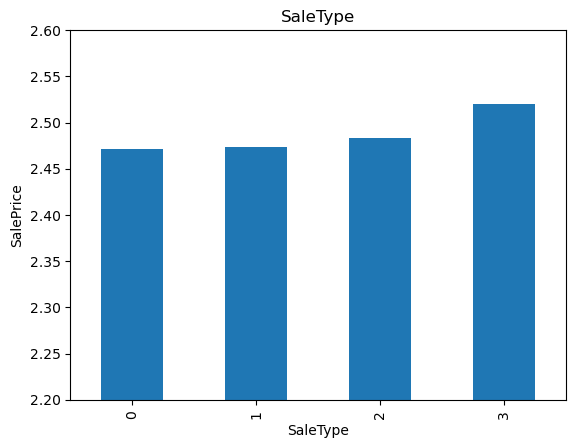
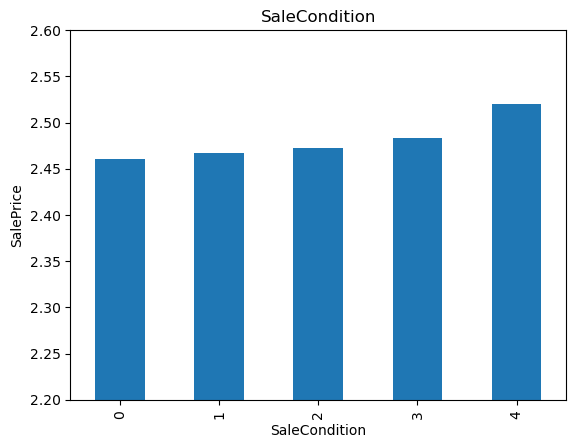
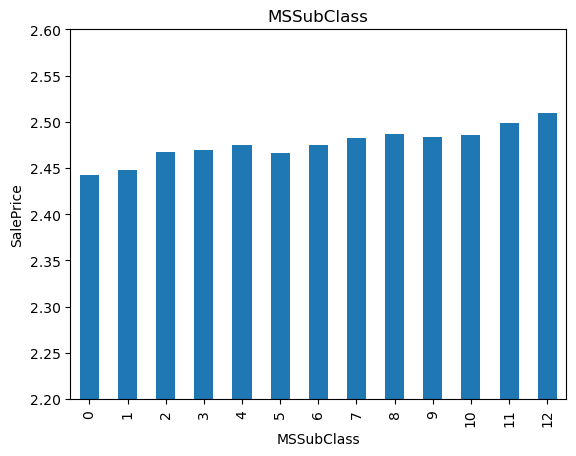
The monotonic relationship is particularly clear for the variables MSZoning and Neighborhood. The higher the integer that now represents the category, the higher the mean house sale price.
(The target is log-transformed, that is why the differences seem so small).
Feature Scaling#
For use in linear models, features need to be scaled. Scaling features to the minimum and maximum values:
1# create scaler
2scaler = MinMaxScaler()
3
4# fit the scaler to the train set
5scaler.fit(X_train)
6
7# transform the train and test set
8
9# sklearn returns numpy arrays, so we wrap the
10# array with a pandas dataframe
11
12X_train = pd.DataFrame(scaler.transform(X_train), columns=X_train.columns)
13
14X_test = pd.DataFrame(scaler.transform(X_test), columns=X_train.columns)
1X_train.head()
| MSSubClass | MSZoning | LotFrontage | LotArea | Street | Alley | LotShape | LandContour | Utilities | LotConfig | LandSlope | Neighborhood | Condition1 | Condition2 | BldgType | HouseStyle | OverallQual | OverallCond | YearBuilt | YearRemodAdd | RoofStyle | RoofMatl | Exterior1st | Exterior2nd | MasVnrType | MasVnrArea | ExterQual | ExterCond | Foundation | BsmtQual | BsmtCond | BsmtExposure | BsmtFinType1 | BsmtFinSF1 | BsmtFinType2 | BsmtFinSF2 | BsmtUnfSF | TotalBsmtSF | Heating | HeatingQC | CentralAir | Electrical | 1stFlrSF | 2ndFlrSF | LowQualFinSF | GrLivArea | BsmtFullBath | BsmtHalfBath | FullBath | HalfBath | BedroomAbvGr | KitchenAbvGr | KitchenQual | TotRmsAbvGrd | Functional | Fireplaces | FireplaceQu | GarageType | GarageYrBlt | GarageFinish | GarageCars | GarageArea | GarageQual | GarageCond | PavedDrive | WoodDeckSF | OpenPorchSF | EnclosedPorch | 3SsnPorch | ScreenPorch | PoolArea | PoolQC | Fence | MiscFeature | MiscVal | MoSold | SaleType | SaleCondition | LotFrontage_na | MasVnrArea_na | GarageYrBlt_na | |
|---|---|---|---|---|---|---|---|---|---|---|---|---|---|---|---|---|---|---|---|---|---|---|---|---|---|---|---|---|---|---|---|---|---|---|---|---|---|---|---|---|---|---|---|---|---|---|---|---|---|---|---|---|---|---|---|---|---|---|---|---|---|---|---|---|---|---|---|---|---|---|---|---|---|---|---|---|---|---|---|---|---|
| 0 | 0.750000 | 0.75 | 0.461171 | 0.366365 | 1.0 | 1.0 | 0.333333 | 1.000000 | 1.0 | 0.0 | 0.0 | 0.863636 | 0.4 | 1.0 | 0.75 | 0.6 | 0.777778 | 0.50 | 0.014706 | 0.049180 | 0.0 | 0.0 | 1.0 | 1.0 | 0.333333 | 0.00000 | 0.666667 | 0.5 | 1.0 | 0.666667 | 0.666667 | 0.666667 | 1.0 | 0.002835 | 0.0 | 0.0 | 0.673479 | 0.239935 | 1.0 | 1.00 | 1.0 | 1.0 | 0.559760 | 0.0 | 0.0 | 0.523250 | 0.000000 | 0.0 | 0.666667 | 0.0 | 0.375 | 0.333333 | 0.666667 | 0.416667 | 1.0 | 0.000000 | 0.0 | 0.75 | 0.018692 | 1.0 | 0.75 | 0.430183 | 0.5 | 0.5 | 1.0 | 0.116686 | 0.032907 | 0.0 | 0.0 | 0.0 | 0.0 | 0.0 | 0.00 | 1.0 | 0.0 | 0.545455 | 0.666667 | 0.75 | 0.0 | 0.0 | 0.0 |
| 1 | 0.750000 | 0.75 | 0.456066 | 0.388528 | 1.0 | 1.0 | 0.333333 | 0.333333 | 1.0 | 0.0 | 0.0 | 0.363636 | 0.4 | 1.0 | 0.75 | 0.6 | 0.444444 | 0.75 | 0.360294 | 0.049180 | 0.0 | 0.0 | 0.6 | 0.6 | 0.666667 | 0.03375 | 0.666667 | 0.5 | 0.5 | 0.333333 | 0.666667 | 0.000000 | 0.8 | 0.142807 | 0.0 | 0.0 | 0.114724 | 0.172340 | 1.0 | 1.00 | 1.0 | 1.0 | 0.434539 | 0.0 | 0.0 | 0.406196 | 0.333333 | 0.0 | 0.333333 | 0.5 | 0.375 | 0.333333 | 0.666667 | 0.250000 | 1.0 | 0.000000 | 0.0 | 0.75 | 0.457944 | 0.5 | 0.25 | 0.220028 | 0.5 | 0.5 | 1.0 | 0.000000 | 0.000000 | 0.0 | 0.0 | 0.0 | 0.0 | 0.0 | 0.75 | 1.0 | 0.0 | 0.636364 | 0.666667 | 0.75 | 0.0 | 0.0 | 0.0 |
| 2 | 0.916667 | 0.75 | 0.394699 | 0.336782 | 1.0 | 1.0 | 0.000000 | 0.333333 | 1.0 | 0.0 | 0.0 | 0.954545 | 0.4 | 1.0 | 1.00 | 0.6 | 0.888889 | 0.50 | 0.036765 | 0.098361 | 1.0 | 0.0 | 0.3 | 0.2 | 0.666667 | 0.25750 | 1.000000 | 0.5 | 1.0 | 1.000000 | 0.666667 | 0.000000 | 1.0 | 0.080794 | 0.0 | 0.0 | 0.601951 | 0.286743 | 1.0 | 1.00 | 1.0 | 1.0 | 0.627205 | 0.0 | 0.0 | 0.586296 | 0.333333 | 0.0 | 0.666667 | 0.0 | 0.250 | 0.333333 | 1.000000 | 0.333333 | 1.0 | 0.333333 | 0.8 | 0.75 | 0.046729 | 0.5 | 0.50 | 0.406206 | 0.5 | 0.5 | 1.0 | 0.228705 | 0.149909 | 0.0 | 0.0 | 0.0 | 0.0 | 0.0 | 0.00 | 1.0 | 0.0 | 0.090909 | 0.666667 | 0.75 | 0.0 | 0.0 | 0.0 |
| 3 | 0.750000 | 0.75 | 0.445002 | 0.482280 | 1.0 | 1.0 | 0.666667 | 0.666667 | 1.0 | 0.0 | 0.0 | 0.454545 | 0.4 | 1.0 | 0.75 | 0.6 | 0.666667 | 0.50 | 0.066176 | 0.163934 | 0.0 | 0.0 | 1.0 | 1.0 | 0.333333 | 0.00000 | 0.666667 | 0.5 | 1.0 | 0.666667 | 0.666667 | 1.000000 | 1.0 | 0.255670 | 0.0 | 0.0 | 0.018114 | 0.242553 | 1.0 | 1.00 | 1.0 | 1.0 | 0.566920 | 0.0 | 0.0 | 0.529943 | 0.333333 | 0.0 | 0.666667 | 0.0 | 0.375 | 0.333333 | 0.666667 | 0.250000 | 1.0 | 0.333333 | 0.4 | 0.75 | 0.084112 | 0.5 | 0.50 | 0.362482 | 0.5 | 0.5 | 1.0 | 0.469078 | 0.045704 | 0.0 | 0.0 | 0.0 | 0.0 | 0.0 | 0.00 | 1.0 | 0.0 | 0.636364 | 0.666667 | 0.75 | 1.0 | 0.0 | 0.0 |
| 4 | 0.750000 | 0.75 | 0.577658 | 0.391756 | 1.0 | 1.0 | 0.333333 | 0.333333 | 1.0 | 0.0 | 0.0 | 0.363636 | 0.4 | 1.0 | 0.75 | 0.6 | 0.555556 | 0.50 | 0.323529 | 0.737705 | 0.0 | 0.0 | 0.6 | 0.7 | 0.666667 | 0.17000 | 0.333333 | 0.5 | 0.5 | 0.333333 | 0.666667 | 0.000000 | 0.6 | 0.086818 | 0.0 | 0.0 | 0.434278 | 0.233224 | 1.0 | 0.75 | 1.0 | 1.0 | 0.549026 | 0.0 | 0.0 | 0.513216 | 0.000000 | 0.0 | 0.666667 | 0.0 | 0.375 | 0.333333 | 0.333333 | 0.416667 | 1.0 | 0.333333 | 0.8 | 0.75 | 0.411215 | 0.5 | 0.50 | 0.406206 | 0.5 | 0.5 | 1.0 | 0.000000 | 0.000000 | 0.0 | 1.0 | 0.0 | 0.0 | 0.0 | 0.00 | 1.0 | 0.0 | 0.545455 | 0.666667 | 0.75 | 0.0 | 0.0 | 0.0 |
1# Save the train and test sets for the next notebook!
2
3X_train.to_csv(f"{data_path}/xtrain.csv", index=False)
4X_test.to_csv(f"{data_path}/xtest.csv", index=False)
5
6y_train.to_csv(f"{data_path}/ytrain.csv", index=False)
7y_test.to_csv(f"{data_path}/ytest.csv", index=False)
1# now let's save the scaler
2
3joblib.dump(scaler, f"{data_path}/minmax_scaler.joblib")
['./datasets/minmax_scaler.joblib']

